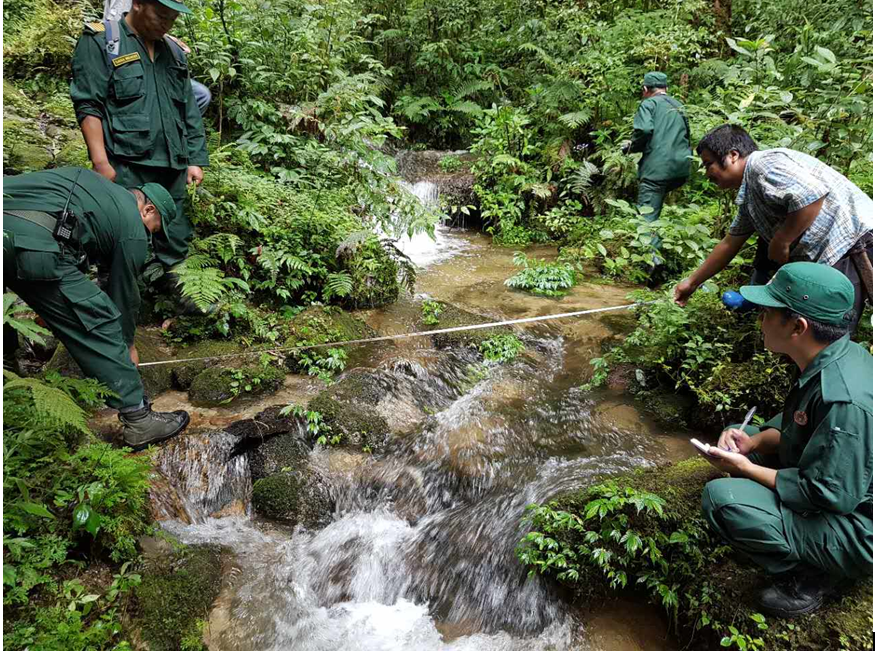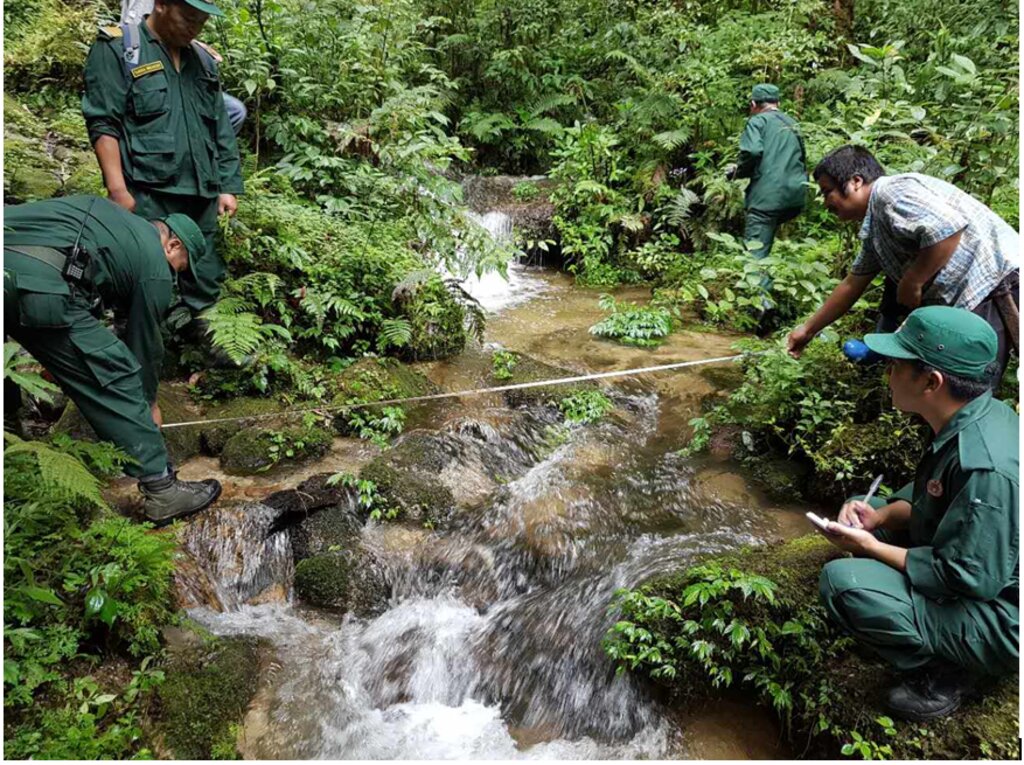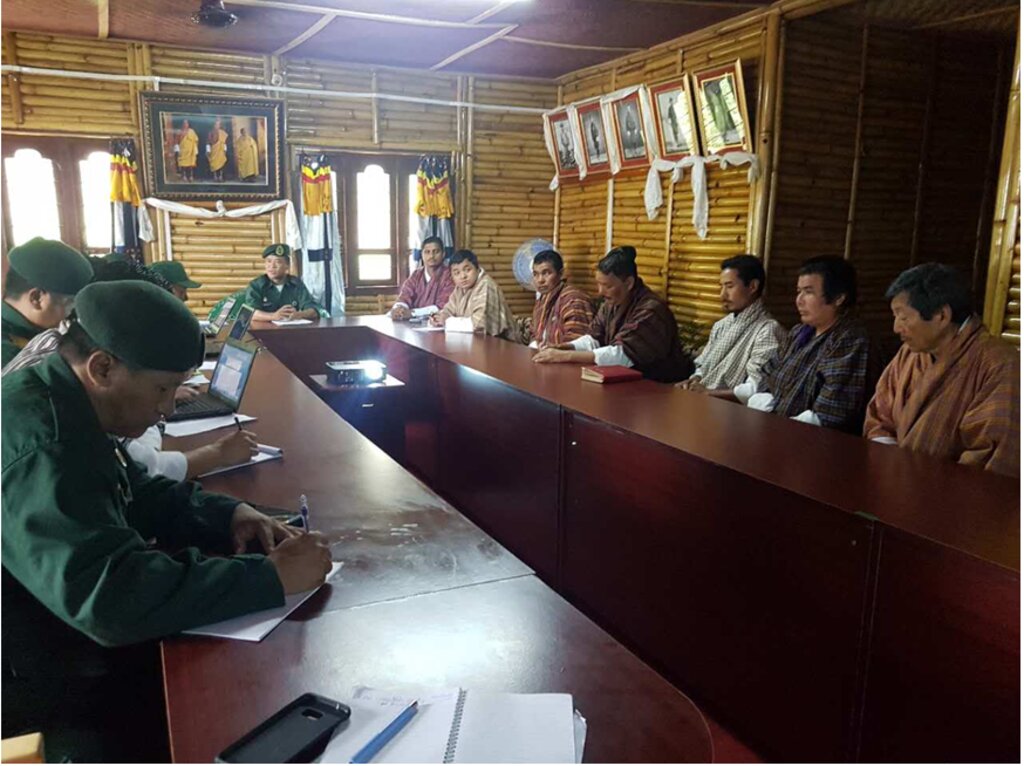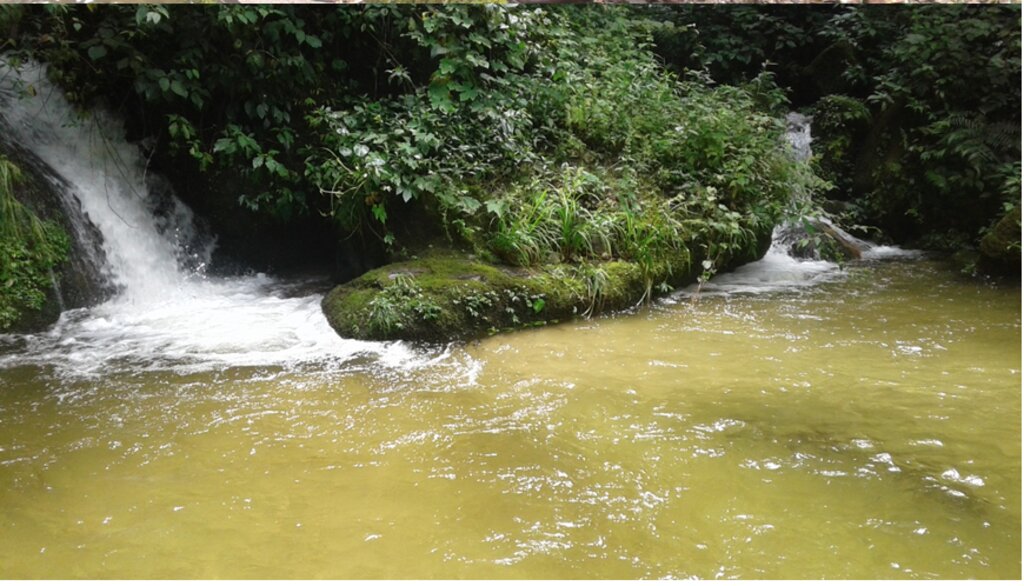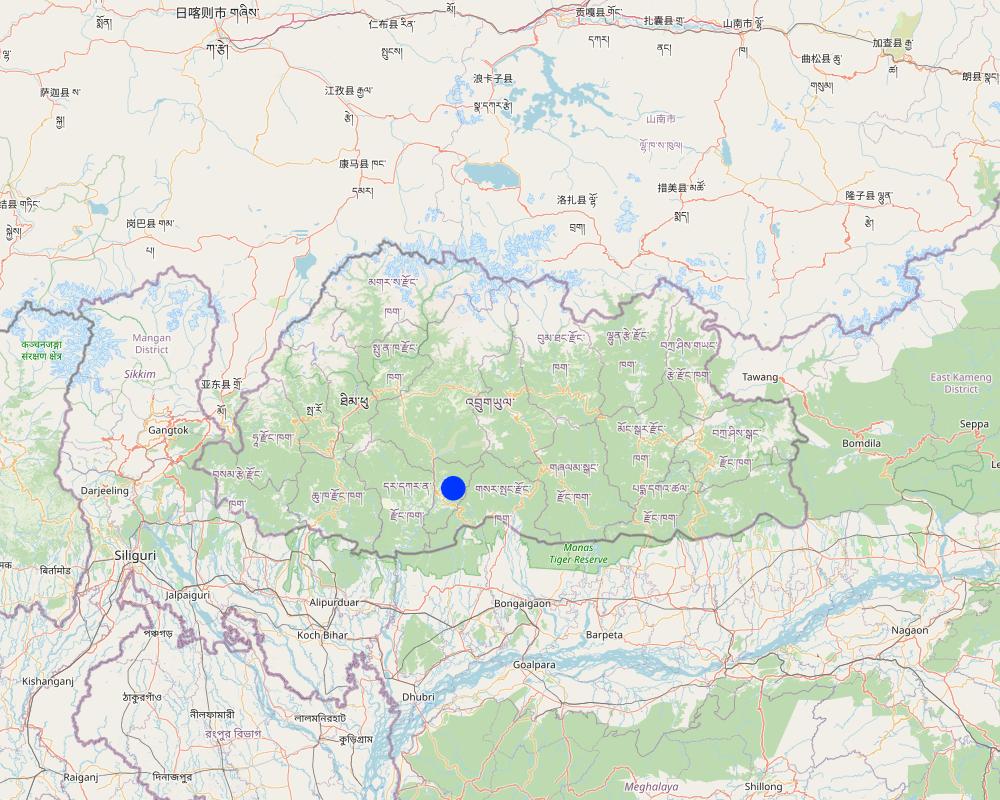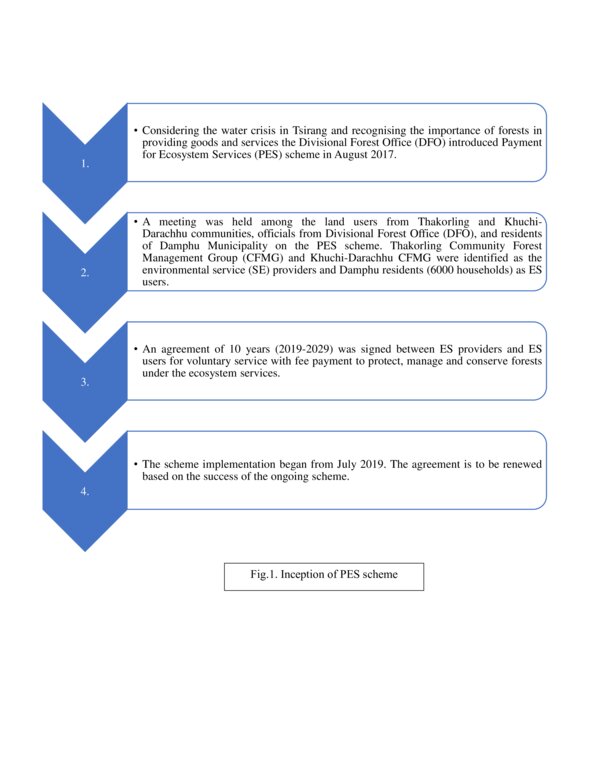Sustaining Drinking Water through Payment for Environment Services (PES) [Bhutan]
- Creation:
- Update:
- Compiler: Tshering Yangzom
- Editor: Haka Drukpa
- Reviewers: William Critchley, Rima Mekdaschi Studer
PES
approaches_6862 - Bhutan
View sections
Expand all Collapse all1. General information
1.2 Contact details of resource persons and institutions involved in the assessment and documentation of the Approach
Key resource person(s)
land user:
Tamang Lhasang
17765702
Thakorling, Tsirang Dzongkhag
Bhutan
land user:
Tamang Dawa
17831694
Thakorling, Tsirang Dzongkhag
Bhutan
land user:
Sunwar Ganesh
17804899
Thakorling, Tsirang Dzongkhag
Bhutan
land user:
Ghalley Basant Kumar
17714794
Thakorling, Tsirang Dzongkhag
Bhutan
land user:
Rai Bal Bir
17638940
Thakorling, Tsirang Dzongkhag
Bhutan
Name of project which facilitated the documentation/ evaluation of the Approach (if relevant)
Sustainable Land Management Project, Bhutan (SLMP)Name of the institution(s) which facilitated the documentation/ evaluation of the Approach (if relevant)
National Soil Services Center, Department of Agric (National Soil Services Center, Department of Agric) - Bhutan1.3 Conditions regarding the use of data documented through WOCAT
When were the data compiled (in the field)?
18/07/2023
The compiler and key resource person(s) accept the conditions regarding the use of data documented through WOCAT:
Ja
2. Description of the SLM Approach
2.1 Short description of the Approach
This approach compensates land users annually for taking care of a water source and its surroundings. The source is being looked after by two groups of environmental service providers and water is supplied to seven gewogs and Damphu Municipality in the Tsirang Dzongkhag.
2.2 Detailed description of the Approach
Detailed description of the Approach:
Due to shortages of good quality water, and the need for protection of the watershed to improve quality and quantity, a “Payment for Ecosystem Services” (PES) contractual agreement has been put into place between providers of the services and users. This strategy's primary goal is to maintain the availability of drinking water for places experiencing shortages. The agreement is between the Thakhorling Community Forest Management Group (CFMG) referred to as the "Primary Provider" and Khuchi-Darachhu CFMG as the "Secondary Provider" of environmental services (ES), and the Drinking Water users of Damphu referred to as “Users” of the drinking water source. Official government intermediaries administer the payment for environmental services (PES) mechanism to ensure that it is implemented successfully between the providers and the user.
Under the agreement,
•The ES Providers pledge that a buffer strip of 100 meters shall be maintained on both sides of the stream, where no vegetation or trees can be removed or harvested, and no grazing is permitted. This helps ensure proper recharging of spring sources as well as improving water quality.
•The ES Providers agree to plant native species annually to rehabilitate degraded watersheds.
•The ES Primary Provider commits to guarding the entire watershed from illegal extraction and overgrazing to improve vegetation cover and to ensure the continuous flow of springs.
•The ES Primary Provider promises to clear stream channels every four months to facilitate continuous flow of water.
•The ES Users take responsibility to pay for all the activities undertaken by ES Providers for the protection of the watershed.
•The ES Providers (both primary and secondary) will receive (approx.) US $2700 per year from the Users. The payment is included in the monthly water bill, collected by the Municipal Authority of Damphu, and released to the ES Providers annually. However, in case of increase in water users from current numbers (6000), an additional fee collected will also be released to ES Providers as an additional incentive.
•In the event the ES Provider fails to carry out the activities as agreed, the Dzongkhag Administration has the authority to retain the PES fee of the failed activity and release the fees for other activities.
This agreement is valid for a period of ten years from July 2019 until June 2029 and may be renewed or extended based on the consensus of the parties. To execute the agreement, two water user groups were formed with a chair and committee, and these created tight by-laws. Once every three months, the chairman inspects the water source's cleaning process – for which the workers receive compensation. The land users work in groups to preserve the water source and the surroundings, and they are paid annually. Each year, the groups must plant trees on an acre of land (0.4 ha) close to the water supply.
Monitoring and evaluation of the PES are conducted twice a year - in June and in December- by the officials from Dzongkhag, Municipal, Thromde and Forest Division. After a successful evaluation, they sign a form which is essential to ensure the annual budget for the PES.
Since the water source is in Thakorling, the land users' permission was crucial to supply water to other locations. Many initially opposed the notion of sharing the water source because they believed it would one day result in a water shortage in their own region. But consultations helped them change their minds. Officials gave them assurances that should a water crisis emerge in the Thakorling area, the municipality and Thromde vowed to provide them with water at any cost. Almost everyone accepted the agreement though there are still a small number of people who disagree.
2.3 Photos of the Approach
2.5 Country/ region/ locations where the Approach has been applied
Country:
Bhutan
Region/ State/ Province:
Tsirang
Further specification of location:
Thakorling village
Comments:
The water source is in Paw Khola, but the compiler was unable to travel there because of the distance and heavy rain. For Paw Khola, which also has a Community Forest, the geocoordinates that were shown on the Google map were used.
Map
×2.6 Dates of initiation and termination of the Approach
Indicate year of initiation:
2019
Year of termination (if Approach is no longer applied):
2029
Comments:
This agreement shall be valid for a period of ten years starting from 1st July 2019 till 30th June 2029 and may be renewed or extended based on the consensus of the parties with prior notice of six months before the date of expiry of the agreement.
2.7 Type of Approach
- project/ programme based
2.8 Main aims/ objectives of the Approach
To protect the water source and maintain continuous supply of clean water to 7 geogs, Damphu Municipality and other institutions.
To protect the water source and distribute water to areas where there is a scarcity.
2.9 Conditions enabling or hindering implementation of the Technology/ Technologies applied under the Approach
social/ cultural/ religious norms and values
- enabling
The land users were willing to share the water source with the other users.
- hindering
Some land users were against this idea as they thought they might face water scarcity in the community in the future.
availability/ access to financial resources and services
- enabling
The funds required to implement this plan were all provided by the government.
institutional setting
- enabling
Groups were formed to protect water source.
collaboration/ coordination of actors
- enabling
The land users worked collectively when they had to clean and carry out maintenance works.
legal framework (land tenure, land and water use rights)
- enabling
PES group formed for ten years with agreement signed between Parties (Service Providers and Service Users).
policies
- enabling
Section 47 of Forest Act 2023 provides support for the establishment of PES.
markets (to purchase inputs, sell products) and prices
- enabling
Market and price is determined by the agreement signed between Service Providers and Service Users.
workload, availability of manpower
- enabling
Workload is eased by the presence of other land users (availability of manpower).
3. Participation and roles of stakeholders involved
3.1 Stakeholders involved in the Approach and their roles
- local land users/ local communities
Land users
Land users formed groups to protect, manage and conserve forests under the ecosystem services.
- Thromde, Municipal and Divisional Forest Office.
Thromde, Municipal and Divisional Forest Office.
Conduct PES meetings, allocate budget and monitor and evaluate the activities carried out by the land users.
3.2 Involvement of local land users/ local communities in the different phases of the Approach
| Involvement of local land users/ local communities | Specify who was involved and describe activities | |
|---|---|---|
| initiation/ motivation | none | Considering the water crisis in Tsirang and recognising the importance of forests in providing goods and services the Divisional Forest Office (DFO) introduced Payment for Ecosystem Services (PES) scheme in August 2017. |
| planning | interactive | Both land users and government officials were involved while establishing the approach. |
| implementation | interactive | ES providers, Thakorling Community Forest Management Group (CFMG) and Khuchi-Darachhu CFMG protect, manage and conserve forests under the ecosystem services. ES users pay for all the activities undertaken by ES providers. Divisional Forest Office looks after the overall conduct of activities in the PES scheme. |
| monitoring/ evaluation | interactive | Divisional Forest Office and land users were involved. |
3.3 Flow chart (if available)
3.4 Decision-making on the selection of SLM Technology/ Technologies
Were decisions on the selection of the Technology(ies) made:
- Divisional Forest Office and Damphu Municipality in consultation with the land users.
Explain:
There water was abundant in Thakorling and Khuchi-Darachhu so the Divisional Forest Office (DFO) introduced the PES scheme. The technologies under the approach were decided via consultations among the ES providers and users and DFO.
Specify on what basis decisions were made:
- evaluation of well-documented SLM knowledge (evidence-based decision-making)
- personal experience and opinions (undocumented)
4. Technical support, capacity building, and knowledge management
4.1 Capacity building/ training
Was training provided to land users/ other stakeholders?
Nee
4.2 Advisory service
Do land users have access to an advisory service?
Ja
Specify whether advisory service is provided:
- on land users' fields
Describe/ comments:
The ES providers have to carry out certain regular activities like cleaning the stream, afforestation, guarding community forest against illegal extraction of forest resources, limiting the number of cattle members, and maintaining sanitation and hygiene, among others. The land users have access to advisory services mostly from the Divisional Forest Office.
4.3 Institution strengthening (organizational development)
Have institutions been established or strengthened through the Approach?
- yes, greatly
Specify the level(s) at which institutions have been strengthened or established:
- local
Describe institution, roles and responsibilities, members, etc.
The two community forest management groups identified as the ES providers have a chairperson, a secretary, and an accountant each (appointed from among the land users). The land users jointly carry out activities like cleaning the stream, afforestation, guarding community forest against illegal extraction of forest resources, limiting the number of cattle members, and maintaining sanitation and hygiene, among others.
Specify type of support:
- financial
Give further details:
The finances come from the water users annually thereby resulting in the generation of income for the land users/ ES providers.
4.4 Monitoring and evaluation
Is monitoring and evaluation part of the Approach?
Ja
If yes, is this documentation intended to be used for monitoring and evaluation?
Nee
4.5 Research
Was research part of the Approach?
Nee
5. Financing and external material support
5.1 Annual budget for the SLM component of the Approach
If precise annual budget is not known, indicate range:
- < 2,000
Comments (e.g. main sources of funding/ major donors):
Environmental services users.
5.2 Financial/ material support provided to land users
Did land users receive financial/ material support for implementing the Technology/ Technologies?
Ja
If yes, specify type(s) of support, conditions, and provider(s):
Finacial support from the environmental services users.
5.3 Subsidies for specific inputs (including labour)
- none
If labour by land users was a substantial input, was it:
- voluntary
5.4 Credit
Was credit provided under the Approach for SLM activities?
Nee
5.5 Other incentives or instruments
Were other incentives or instruments used to promote implementation of SLM Technologies?
Nee
6. Impact analysis and concluding statements
6.1 Impacts of the Approach
Did the Approach empower local land users, improve stakeholder participation?
- No
- Yes, little
- Yes, moderately
- Yes, greatly
All the land users works collectively in groups to protect, manage and conserve forests
Did the Approach help land users to implement and maintain SLM Technologies?
- No
- Yes, little
- Yes, moderately
- Yes, greatly
The land users carry out SLM activities such as afforestation, guarding community forest against illegal extraction of forest resources, limiting the number of cattle members, and maintaining sanitation and hygiene, among others.
Did the Approach improve coordination and cost-effective implementation of SLM?
- No
- Yes, little
- Yes, moderately
- Yes, greatly
The land users work collectively towards the shared goal of forest protection via funds from the ES users.
Did the Approach mobilize/ improve access to financial resources for SLM implementation?
- No
- Yes, little
- Yes, moderately
- Yes, greatly
The approach has improved access to financial resources via funds from the ES users.
Did the Approach improve knowledge and capacities of land users to implement SLM?
- No
- Yes, little
- Yes, moderately
- Yes, greatly
The land users are mostly engaged in small but important SLM activities such as afforestation, guarding community forest against illegal extraction of forest resources, limiting the number of cattle members, and so on.
Did the Approach build/ strengthen institutions, collaboration between stakeholders?
- No
- Yes, little
- Yes, moderately
- Yes, greatly
All the land users work collectectively in groups to manage and conserve forests.
Did the Approach mitigate conflicts?
- No
- Yes, little
- Yes, moderately
- Yes, greatly
Water crisis has been solved.
Did the Approach empower socially and economically disadvantaged groups?
- No
- Yes, little
- Yes, moderately
- Yes, greatly
The land users from various backgrounds are part of ES providers.
Did the Approach improve gender equality and empower women and girls?
- No
- Yes, little
- Yes, moderately
- Yes, greatly
Both men and women are in the groups of ES providers.
Did the Approach encourage young people/ the next generation of land users to engage in SLM?
- No
- Yes, little
- Yes, moderately
- Yes, greatly
The approach is focused on forest management and conservation and it positively showcases the benefits of managing and protecting the forests.
Did the Approach lead to improved food security/ improved nutrition?
- No
- Yes, little
- Yes, moderately
- Yes, greatly
ES providers get some amount from the ES users and this amount increases the access to financial resources. Improved access to financial resources in turn increases the access to improved food or nutrition.
Did the Approach lead to improved access to water and sanitation?
- No
- Yes, little
- Yes, moderately
- Yes, greatly
ES users have access to clean and continuous water.
Did the Approach improve the capacity of the land users to adapt to climate changes/ extremes and mitigate climate related disasters?
- No
- Yes, little
- Yes, moderately
- Yes, greatly
This approach encourages afforestation, reduced overgrazing or clearing of vegetation which can indirectly be related to fighting climate change in small ways.
Did the Approach lead to employment, income opportunities?
- No
- Yes, little
- Yes, moderately
- Yes, greatly
The land users are able to generate income through their environmental services to the ES users.
6.2 Main motivation of land users to implement SLM
- payments/ subsidies
The land users receive money per year in order to protect the water source.
- conflict mitigation
Water scarcity in some places has reduced.
6.3 Sustainability of Approach activities
Can the land users sustain what has been implemented through the Approach (without external support)?
- yes
If yes, describe how:
PES scheme is sustainable without external support as long as the ES providers keep on providing environmental services and the ES users pay for the services. Also, this scheme promotes the different practices of protecting, managing and conserving forests such as afforestation, guarding against illegal extraction of forest resources, and limiting the number of cattle which are all sustainable practices.
6.4 Strengths/ advantages of the Approach
| Strengths/ advantages/ opportunities in the land user’s view |
|---|
| Improved access to financial resources. |
| Deeping of SLM knowledge of the land users because of different sustainable forest management practices carried out. |
| Sustainable PES scheme as the fund is generated by the ES users with no reliance on external funding. |
| Strengths/ advantages/ opportunities in the compiler’s or other key resource person’s view |
|---|
| Since the land users plant trees each year and have strict rules and regulations to protect the environment, it helps in environmental conservation. |
| Help preserve natural resources and educate the local people on how to protect the continuous flow of water from the sources. |
6.5 Weaknesses/ disadvantages of the Approach and ways of overcoming them
| Weaknesses/ disadvantages/ risks in the land user’s view | How can they be overcome? |
|---|---|
| Water shortage during winter season. | The land users have constructed water harvesting ponds. |
| Disagreements in the implementation of plans during the initial period. | Held meetings to clear the confusion and solve the disagreements. |
| Weaknesses/ disadvantages/ risks in the compiler’s or other key resource person’s view | How can they be overcome? |
|---|---|
| Dispute among the members. | Through discussions |
| Water crisis in the near future as the land users share water from a single source. | Protect the water source and use water wisely. |
7. References and links
7.1 Methods/ sources of information
- interviews with land users
5 informants
7.3 Links to relevant information which is available online
Title/ description:
Protecting the water source of Damphu town through PES scheme
URL:
https://www.bbs.bt/news/?p=118173#:~:text=Beginning%20this%20month%2C%20the%20residents,forest%20of%20the%20two%20chiwogs.
Title/ description:
Payment for Environmental Services scheme established in Tsirang
URL:
https://www.facebook.com/search/top/?q=payment%20for%20environmental%20service%20established%20in%20Tsirang%202019
Links and modules
Expand all Collapse allLinks
No links
Modules
No modules


